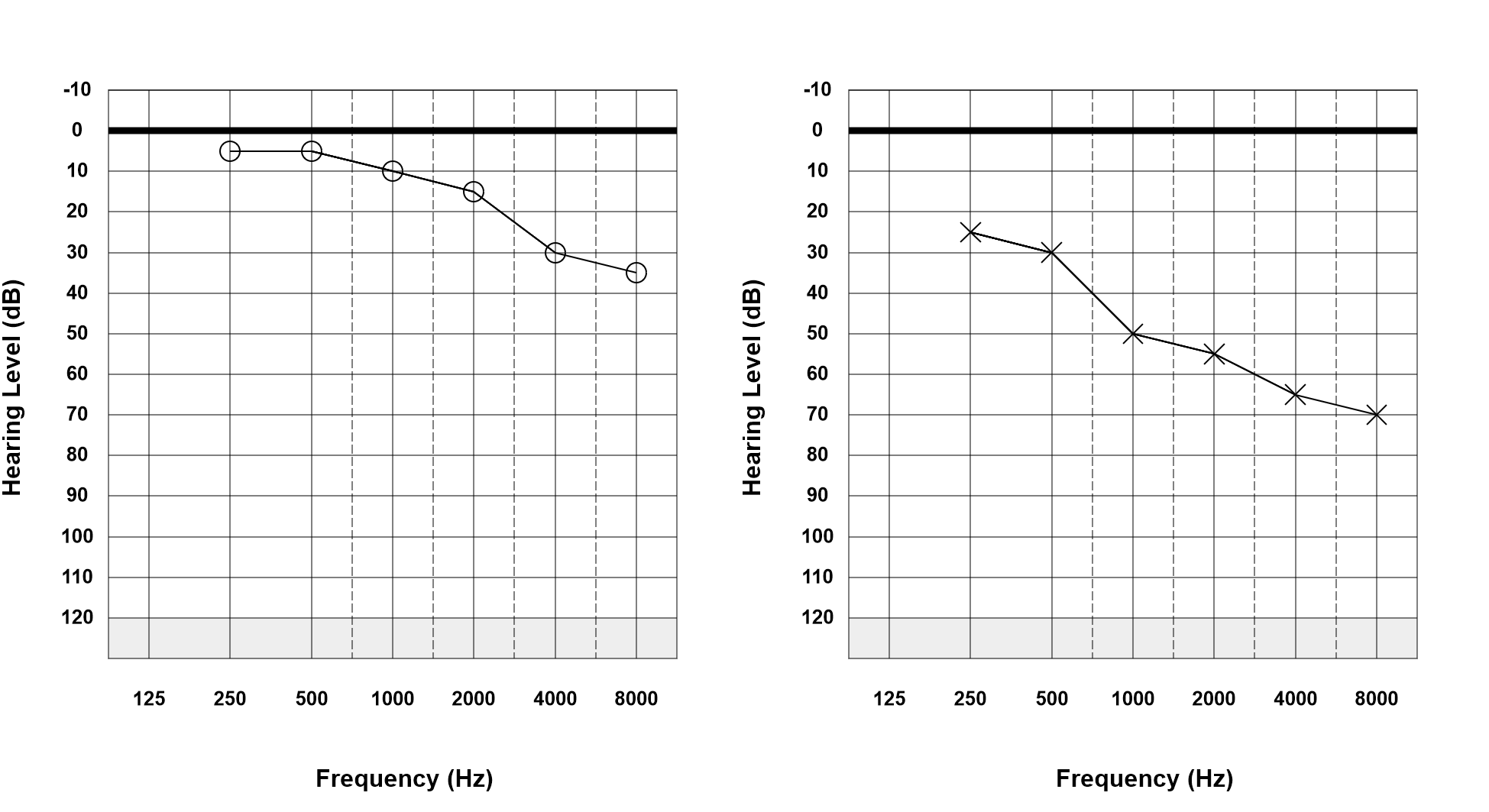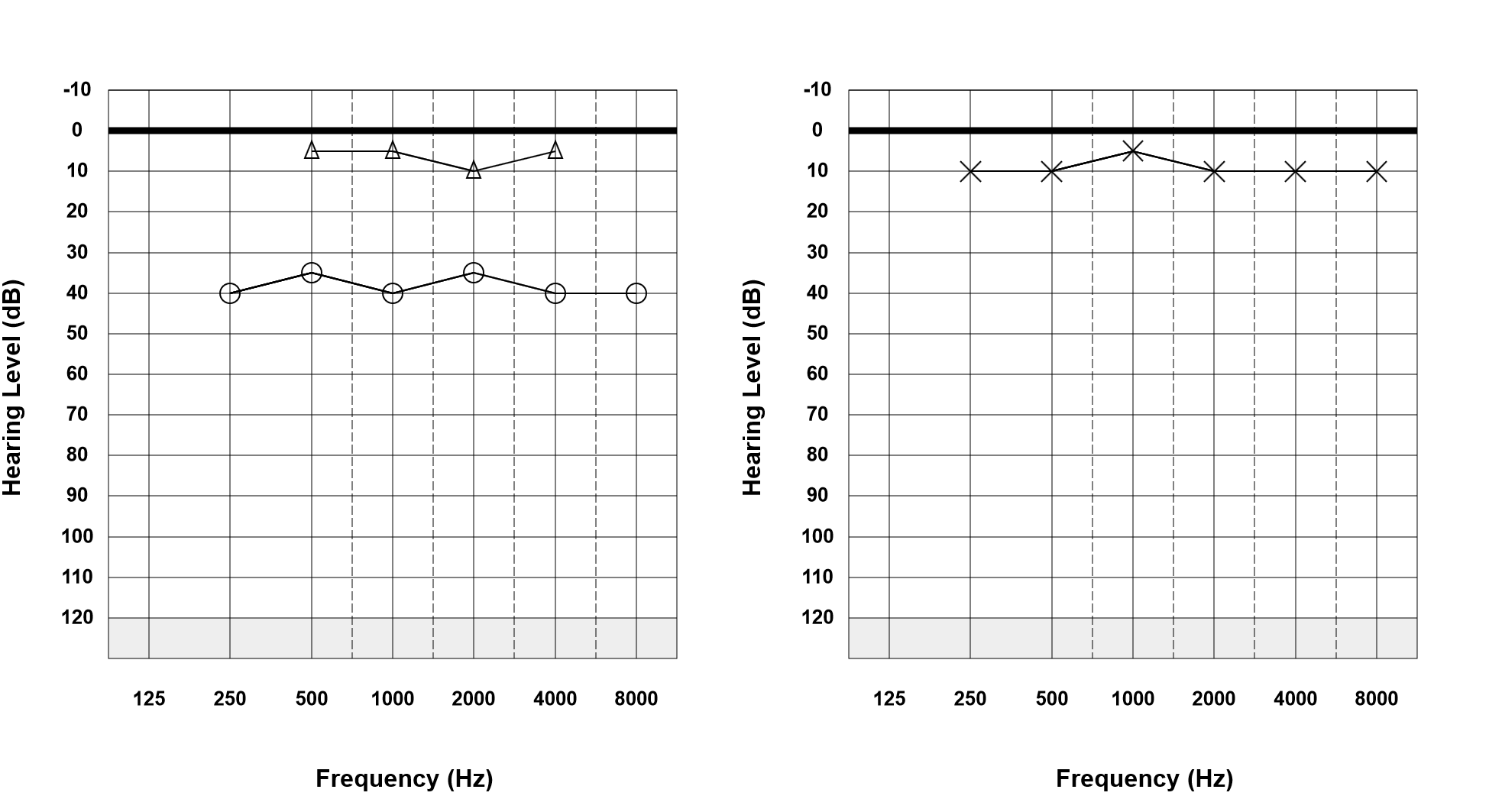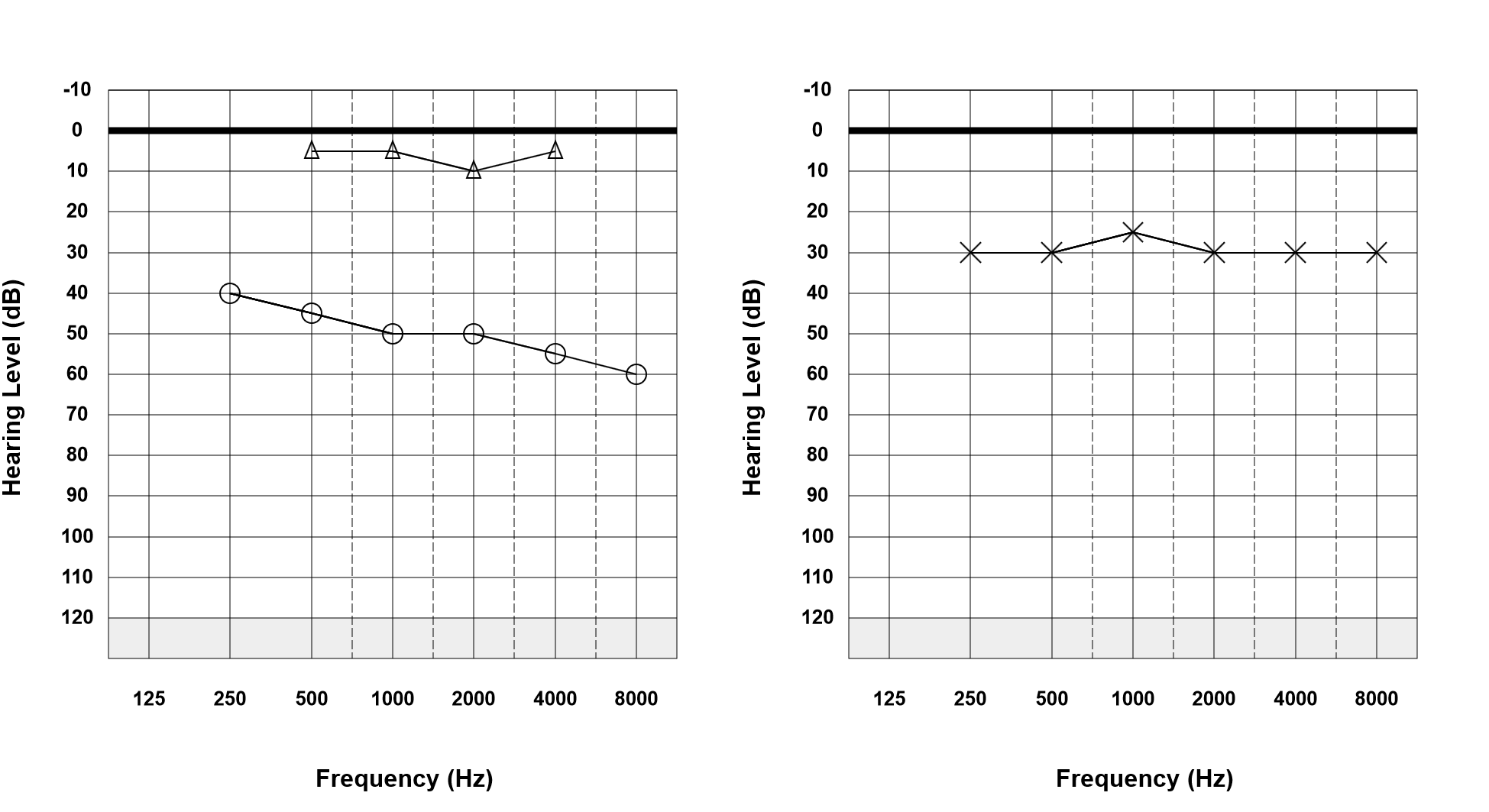 |
PTA (Masking) Tutorial |
Introduction
If you are on a clinical placement, or working in clinic team you could ask placement team member to help you run through this work. Please contact me if you have difficulties viewing the video material. Videos are hosted on Youtube (as unlisted videos), some NHS sites block Youtube. It may be possible for me to provide the videos by other means.
How to use this tutorial
This tutorial is split in to three actions.- Section 1: Learn
The first section "Learn" covers revision material on Masking theory. This section will cover: Underlying theory of cross-hearing and masking The rules of masking example audiograms with accompanying videos of masking procedure runthrough on a patient simulator.
- Section 2: Active Learning task
The second section "Active Learning task" will cover how to use the online audiometry simulator and example patients which require masking. You can actively perform masked PTA using the simulator and check your measured audiogram against the expected answer.
- Section 3: Reflection and Summary
The third section "Reflection and Summary" summaries the learning activities, and suggests how to identify where further study is required.
Click the title banner of the section to move to that section (it is strongly suggested that you work through the sections in order).
1- Learn
- 1.1-Principles of cross-hearing
- 1.2-Principles of Masking
- 1.3-The three Rules of Masking
- 1.4-How to mask (procedures and
examples)
The principles of cross-hearing
Full screen viewing is recommended, please also select the highest quality to ensure the screen recording is clear.
Youtube automatically generated (speech recognition) subtitles may be available, be warned that the subtitles may contain inaccuracies.
You may find that this introduction to cross-hearing presentation is a little tricky to follow as it introduces many concepts. If this is the case I suggest that you read more about cross-hearing and masking in the BSA recommended procedures, and in core text books such as Gefand and Katz (see reading lists for the courses which you are enrolled on). The BSA recommended procedures contain three rules of masking which help when learning about cross-hearing and masking. See the later sections for details on the rules of masking. You may initially find it easier to remember the rules of masking and then after that come to a more fuller understanding of cross-hearing.The principles of masking
Full screen viewing is recommended, please also select the highest quality to ensure the screen recording is clear.
Youtube automatically generated (speech recognition) subtitles may be available, be warned that the subtitles may contain inaccuracies.
This video discusses the principles of masking. The next section on the three rules of masking gives details on how to work out when to mask.The three rules of masking
Full screen viewing is recommended, please also select the highest quality to ensure the screen recording walkthrough is clear.
Youtube automatically generated (speech recognition) subtitles may be available, be warned that the subtitles may contain inaccuracies.
This video covers the rules of masking. Later videos run through the process and procedures.How to mask
Procedural Guidance
University of Manchester procedural guidance for common clinical variations of PTA, and some commonly asked questions are available in the generic clinical handbook. They can also be viewed HERE.
The first video below discusses the BSA recommended procedures for masking. Masking functions which are explained in the procedures are also discussed in the second half of the video to aid the link between theory and practice.Full screen viewing is recommended, please also select the highest quality to ensure the screen recording walkthrough is clear.
Youtube automatically generated (speech recognition) subtitles may be available, be warned that the subtitles may contain inaccuracies.
Not-masked PTA followed by Rule 1 and 2 masking.
The video below shows a walkthrough of a full PTA with rule 1 and 2 masking. The video begins with the not-masked threshold procedure. The masking begins 5 minutes and 10 seconds into the video, skip ahead if you wish.Full screen viewing is recommended, please also select the highest quality to ensure the screen recording walkthrough is clear.
Youtube automatically generated (speech recognition) subtitles may be available, be warned that the subtitles may contain inaccuracies.
2- Active Learning Task.
How to use the audiometry simulator.
This section covers active learning tasks which enable you to run through some practice sessions using an online PTA test subject simulator. Firstly you should familiarise yourself with the online PTA simulator. The instructions can be found HERE. Once you have done that you are ready to continue to the next sections which cover the three rules of masking separately. Within each section you will see links which take you to the PTA subject simulator. Each link sets the parameters for the test subject discussed within each tutorial section. Be sure to use the links in the sections to access each tutorial when working on each section rather than the link above.
Rule one
Go back to the "learning section" of this tutorial if you are unsure what rule 1 is.
Task One
Look at the audiogram below. It is a working audiogram prior to any masking being performed (note that the BSA symbols for AC are masked if required, in this case masking has not yet been done). TDH39 headphones were used for the AC threshold measurements.
Which frequencies should be masked (by rule 1)?

The table below shows the calculations needed for rule 1.
| Frequency (Hz) | 250 | 500 | 1000 | 2000 | 4000 | 8000 |
| Right AC threshold (dB HL) | 5 | 5 | 10 | 15 | 30 | 35 |
| Left AC threshold (dB HL) | 25 | 30 | 50 | 55 | 65 | 70 |
| Difference | 20 | 25 | 40 | 40 | 35 | 35 |
You can move this answer window up/down to enable you to see the audiogram in the question.
Task Two
Find the true thresholds using rule 1 masking procedures in the patient simulator HERE
Reveal AnswerThe true AC threshold at 1000 Hz is 55 dB HL and at 2000 Hz it is 55 dB HL. This indicates a small change at 1 kHz. Remember that your answers should be correct within a 5 dB step size.
Task Three
Find the true thresholds using rule 1 masking procedures in the patient simulator HERE (the not-masked AC has already been completed and can be viewed in the audiogram tab of the simulator). Look at the working audiogram which contains the not-masked AC first, then decide which points to mask and complete the masking to find true thresholds.
Reveal AnswerThe answer is that all thresholds on the right ear are not reached at the maximum output level. As BC has not been performed yet it is not possible to determine the type of loss. The right ear may be a "dead ear", or could possibly be a mixed loss with moderate or worse SNHL and a conductive element. It may not be possible to obtain this information from the PTA alone due to the limited range of output of the BC transducer.
Rule two
Go back to the "learning section" of this tutorial if you are unsure what rule 2 is.
Task One
Look at the audiogram below. It is a working audiogram prior to any masking being performed (note that the BSA symbols for AC are masked if required, in this case masking has not yet been done). TDH39 headphones were used for the AC threshold measurements.
Which frequencies should be masked (by rule 2)?

All left AC thresholds are within 10 dB of AC thresholds. There is no air-bone gap on the left ear which would require masking.
The right AC thresholds and not-masked BC thresholds are tabulated below. All BC thresholds on the right must be masked as the 500 Hz, 1000 Hz, 2000 Hz and 4000 Hz AC thresholds are more than 10 dB worse than the not-masked BC.
At present, without masking, it is not possible to know if the right hearing loss is sensorineural, conductive or mixed.
| Frequency (Hz) | 250 | 500 | 1000 | 2000 | 4000 | 8000 |
| Right not-masked BC threshold (dB HL) | 5 | 5 | 10 | 5 | ||
| Right AC threshold (dB HL) | 40 |
35 | 40 | 35 | 40 | 40 |
| Difference | 30 |
35 |
25 |
35 |
Task 2
Find the true BC thresholds using the rule 2 masking procedures in the patient simulator HERE (the not-masked AC has already been completed and can be viewed in the audiogram tab of the simulator). Look at the working audiogram which contains the AC thresholds and the not-masked BC. Using your answer to task 1 (check it is correct) complete the masking to find true BC thresholds.
Reveal AnswerYou should find that the right hearing loss is conductive (BC thresholds in normal range).
Rule three
Rule three of masking aims to find the true AC thresholds when a conductive hearing loss exists in the opposite ear. As there is a conductive loss in the opposite ear rule 1 doesn't apply, but as the cross hearing pathway from the AC is to the opposite cochlea, masking is still needed.
Go back to the "learning section" of this tutorial if you are still unsure what rule 3 is.
Task One
Look at the audiogram below. It is a working audiogram prior to any masking being performed (note that the BSA symbols for AC are masked if required, in this case masking has not yet been done). TDH39 headphones were used for the AC threshold measurements.
Which thresholds should be masked (by rule 3)?
You should also consider BC thresholds carefully (rule 2).
As the difference between right AC and left AC thresholds is less than 40 dB at all frequencies rule one masking is not required. However the possibility still exists that the right AC thresholds might have been detected by the left cochlea, and are shadows of the left (move this answer window down to enable you to see the audiogram if needed).
Why is this? Look at the not-masked BC thresholds that have been plot on the right ear. Prior to rule 2 masking the possibility exists that the measured not-masked BC thresholds came from the left ear, thus there is a 40 dB or more difference between the AC thresholds of one ear and the BC of the opposite ear's cochlear thresholds. Assuming that rule 2 masking is possible without cross-masking you would first mask the right BC as it is the worst ear. If the right masked BC thresholds moved by more than 10 dB then the not-masked thresholds could be attributed to the left ear. If, however, the right masked BC thresholds remained the same or moved by 5, or 10 dB then they are not sufficiently separated from the not-masked and the left BC masked thresholds must be measured too. You should also consider the fact that the thresholds at 250 Hz and those above 4 kHz, where BC is not measured at all, could also be shadows of the opposite ear too.
All BC thresholds on the right must be masked as the 500 Hz, 1000 Hz, 2000 Hz and 4000 Hz AC thresholds are more than 10 dB worse than the not-masked BC. If the right masked BC didn't move, then the left masked BC should be obtained too. This could be difficult because if the right AC thresholds are shadows of the left, because of rule three. If this is true then immediate cross-masking to the left test ear will occur when applying masking noise to the right by AC. So in some cases it might be impossible to find true thresholds, and careful thought is needed to interpret the audiogram as this could be a complex masking dilemma case.
If when masking the left BC thresholds it is found that they are not recordable at 30 dB (or perhaps 35 - 40 dB to allow for calibration issues and possible central-masking) then it could be likely that the not-masked BC applies to the left ear, and the right AC thresholds are shadows due to rule 3. Equally the right AC may not be shadows, but cross-masking could still occur as we need to mask up to EM+30 at least. Finding the right masked BC could be problematic too. If the right masked BC is the same as the not-masked then it should be possible to find the masked thresholds, but if not then most likely we will not be able to mask due to cross-masking and/or running out of masking level (no more increases possible, or uncomfortably too loud).
It is important to write such possibilities on audiogram reports to aid those interpreting them. It is can also be important to note when AC masking has not been applied as the BSA symbols mean masked IF required (it could be required by rule 3 as stated).
Full PTA with masking tasks
Complete audiometry for the following simulated subjects (use masking when needed).
Reveal Answer
Answer 1 (see audiogram below, thresholds should be within 5 dB step-size).

Task 2 Patient simulation HERE.
Reveal Answer
Answer 2 (see audiogram below, thresholds should be within 5 dB step-size).

Task 3 Patient simulation HERE.
Reveal Answer
Answer 3 (see audiogram below, thresholds should be within 5 dB step-size).

Task 4 Patient simulation HERE.
Reveal Answer
Answer 4 (see audiogram below, thresholds should be within 5 dB step-size).

3 - Reflection and summary.
There really is no substitute for performing full PTA with masking in clinic, thinking "on your feet" will become second nature as you progress through clinical aspects of your training either as part of your course (BSc HCS Audiology students), or in CCC year after MSc, or with clinic teams for STP students.
© 2017 Dr Tim Wilding, University of Manchester